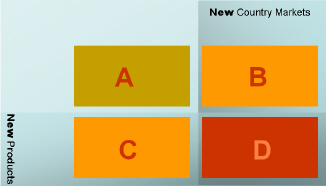Multiple Choice
Identify the
choice that best completes the statement or answers the question.
|
|
|
1.
|
The marketing mix describes a set of variables that an organisation can control
in order to appeal to the target market. Select the item not normally regarded as one of those
variables
a. |
Product |
d. |
Price |
b. |
Place |
e. |
Production |
c. |
Promotion |
|
|
|
2.
|
The international marketing
process is concerned with how work is done to create
marketing strategies and plans. There are three essential stages in the process - select the option
that shows the correct stages in the correct sequence
a. |
Analysis, planning and the development of the marketing programme |
b. |
Analysis, planning
and strategy |
c. |
Analysis, choice and the development of the marketing programme |
d. |
Analysis,strategy
and planning |
|
|
|
3.
|
The international marketing
process is concerned with how work is done to create
marketing strategies and plans. There are three essential stages in the process which includes
analysis. Analysis focuses on the four Cs - select the option that is NOT one of those
“Cs”
a. | Customers | d. | Competitors | b. | Causal-environment | e. | Capabilities | c. | Channels |
|
|
|
4.
|
Select the option that correctly shows the research process
a. |
Approach, problem definition, research design, data gathering, analysis and
report |
b. |
Research design, problem definition, approach, data gathering, analysis and
report |
c. |
Problem definition, approach, research design, data gathering, analysis and
report |
d. |
Problem definition, research design, approach, data gathering, analysis and
report |
|
|
|
5.
|
The Ansoff Growth matrix is a tool to help organizations determine their product
and market growth strategy, select the strategy described below:
“a strategy of
increasing sales of current products in current markets”
a. | Geographic expansion | c. | Market penetration | b. | Diversification | d. | Product
development |
|
|
|
6.
|
Identify the argument that is NOT for product adaptation
a. | Markets becoming more homogeneous | c. | More difficult to
copy | b. | Closer match to requirements | d. | Legal
differences |
|
|
|
7.
|
the Boston Matrix (Also called the BCG Matrix, the Growth-Share Matrix and
Portfolio Analysis) is a well known tool for the marketing manager. Developed by the large US
consulting group, it is an approach to product portfolio planning. The matrix analyses the success of
a company’s products or services by looking at the percentage of sales they have in the market
and how fast the sales are growing. Which of the following is NOT a label for one of the matrix
quadrants/
a. | Cash Cow | c. | Cat | b. | Star | d. | Question Mark |
|
|
|
8.
|
the Boston Matrix (Also called the BCG Matrix, the Growth-Share Matrix and
Portfolio Analysis) is a well known tool for the marketing manager. Which quadrant of the matrix is
described below?
“Products with a dominant share of the market but low prospects for
growth”
a. | Cash Cow | c. | Cat | b. | Star | d. | Question Mark |
|
|
|
9.
|
The Product Life Cycle (PLC), see figure, is a theory based upon the biological
life cycle (we first considered it in chapter 2 when discussing industries); it is a marketing tool
for evaluating products - a model that provides a framework for thinking in detail about product
policy, product introduction and product elimination. Which option identifies the correct stages in
the correct sequence?
a. | Growth, maturity, stability and decline | b. | Introduction,
growth, maturity and decline | c. | Introduction, maturity, growth, and
decline | d. | Introduction, growth, expansion and maturity |
|
|
|
10.
|
The Adoption Process was first described almost fifty years ago but remains an
important marketing tool. This extension of the product life cycle was developed by Rogers in 1962
and simply looks at who adopts products at the different stages of the life cycle. It describes the
behaviour of consumers as they purchase new products and services. Select the category that is not
normally associated with this process
a. | Early majority | c. | Innovators | b. | Laggards | d. | Dogs |
|
|
|
11.
|
Select the item that would not be an argument for adapting International
marketing communications
a. | Wider recognition | c. | Message may be misinterpreted | b. | Cultural
sensitivity | d. | Humour used may
not be understood |
|
|
|
12.
|
Select the item not listed as a pricing strategy in Kelly (2009)
a. | Bait pricing | d. | Demand-based pricing | b. | Penetration pricing | e. | Arbitrary pricing | c. | Cost plus
pricing | f. | Prestige
pricing |
|
|
|
13.
|
Select the label for the pricing strategy described
“a pricing
strategy of setting a price below the prices of competing brands in order to penetrate a market and
produce a larger unit sales volume”
a. | Bait pricing | d. | Demand-based pricing | b. | Penetration pricing | e. | Arbitrary pricing | c. | Cost plus
pricing | f. | Prestige
pricing |
|
|
|
14.
|
Consider the research process shown in the diagram below  Select the
item that corresponds with step 5 a. | Research design | d. | Data analysis | b. | Approach | e. | Problem definition | c. | Data
gathering | f. | Report |
|
|
|
15.
|
 With reference to the Ansoff matrix shown above,
select the option with the correct text for box “B” a. | Diversification | c. | Development | b. | Expansion | d. | Penetration |
|